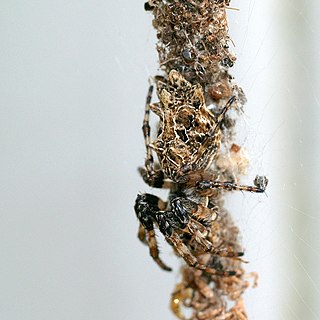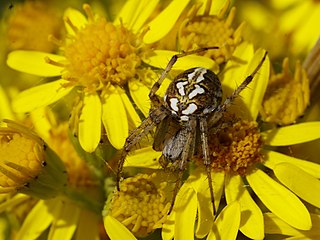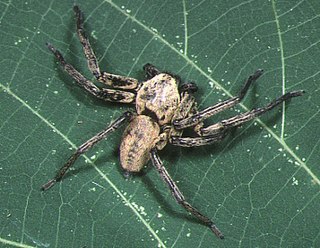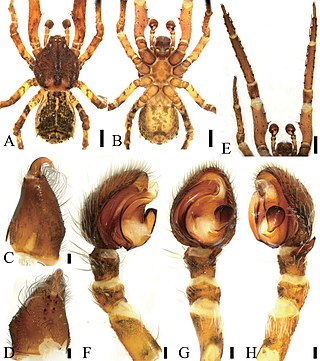
Myrmarachne is a genus of ant-mimicking jumping spiders that was first described by W. S. MacLeay in 1839. They are commonly called ant-mimicking spiders, but they are not the only spiders that have this attribute. The name is a combination of Ancient Greek μύρμηξ, meaning "ant", and ἀράχνη, meaning "spider".

Cosmophasis is a genus of spiders in the family Salticidae. They are predominantly Southeast Asian, while some species occur in Africa and Australia. Although most species more or less mimic ants, there are also colorful species that follow a different strategy.
Emathis is a genus of the spider family Salticidae with ten described species. Half of the species occurs from Sumatra to the Philippines, the other five occur in the West Indies. It is not certain that these two groups should reside within the same genus. This genus is very similar to the closely related Lepidemathis, which are larger.

Epeus is a genus of the spider family Salticidae. They are often found on broad-leaved plants or shrubs of rain forest, or in gardens of Southeast Asia.

Simaetha is a genus of Australasian jumping spiders that was first described by Tamerlan Thorell in 1881. They resemble members of Simaethula and Stertinius.

Cyclosa, also called trashline orbweavers, is a genus of orb-weaver spiders first described by Anton Menge in 1866. Widely distributed worldwide, spiders of the genus Cyclosa build relatively small orb webs with a web decoration. The web decoration in Cyclosa spiders is often linear and includes prey remains and other debris, which probably serve to camouflage the spider. The name "Cyclosa" comes from Greek 'to move in a circle', referring to how it spins its web.

Neoscona, known as spotted orb-weavers and barn spiders, is a genus of orb-weaver spiders (Araneidae) first described by Eugène Simon in 1895 to separate these from other araneids in the now obsolete genus Epeira. The name Neoscona was derived from the Greek νέω, meaning "spin", and σχοῐνος, meaning "reed" They have a mostly pantropical distribution and one species, Neoscona adianta, has a palearctic distribution. As of April 2019 there are eight species that can be found in the United States and Canada:

Chrysso is a genus of comb-footed spiders that was first described by Octavius Pickard-Cambridge in 1882.

Enoplognatha is a genus of comb-footed spiders that was first described by P. Pavesi in 1880. They have both a large colulus and a subspherical abdomen. Males usually have enlarged chelicerae. It is considered a senior synonym of Symopagia.

Thelcticopis is a genus of huntsman spiders that occurs almost exclusively in the area India to Japan to New Guinea and Fiji. However, one species occurs in Costa Rica, and another in Congo basin, although the latter species is probably misplaced in this genus.

Cyrtophora parangexanthematica is a species of tent spider found in the Philippines. Its scientific name comes from its close resemblance to double-tailed tent spiders. It was described from a single female specimen collected in 1995.
Atypena is a genus of Asian dwarf spiders that was first described by Eugène Louis Simon in 1894.

Borboropactus is a genus of crab spiders that was first described by Eugène Louis Simon in 1884.
Rhitymna is a genus of huntsman spiders described in 1897 by Eugène Simon. Members of this genus can be distinguished by a number of characteristics, but it is most often confused with Olios species, many of which also have the Y-shaped pattern on the dorsal opisthosoma.

Coleosoma is a genus of comb-footed spiders that was first described by Octavius Pickard-Cambridge in 1882.
Landoppo is a monotypic genus of Filipino comb-footed spiders containing the single species, Landoppo misamisoriensis. It was first described by A. T. Barrion & J. A. Litsinger in 1995, and is found in the Philippines.

Camaricus is a genus of crab spiders that was first described by Tamerlan Thorell in 1887.
Loxobates is a genus of spiders in the family Thomisidae. It was first described in 1877 by Tamerlan Thorell. As of 2021, it contains 9 Asian species.

Gasteracantha clavigera is a species of spider in the spiny orb-weaver genus Gasteracantha.

Gasteracantha hecata is a species of spider in the spiny orb-weaver genus Gasteracantha. It occurs in the Philippines and has prominent horn-like spines on its abdomen.














